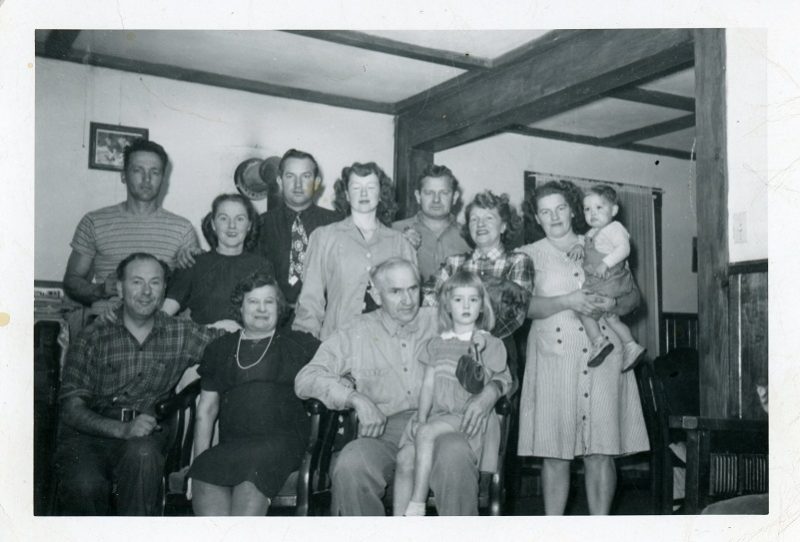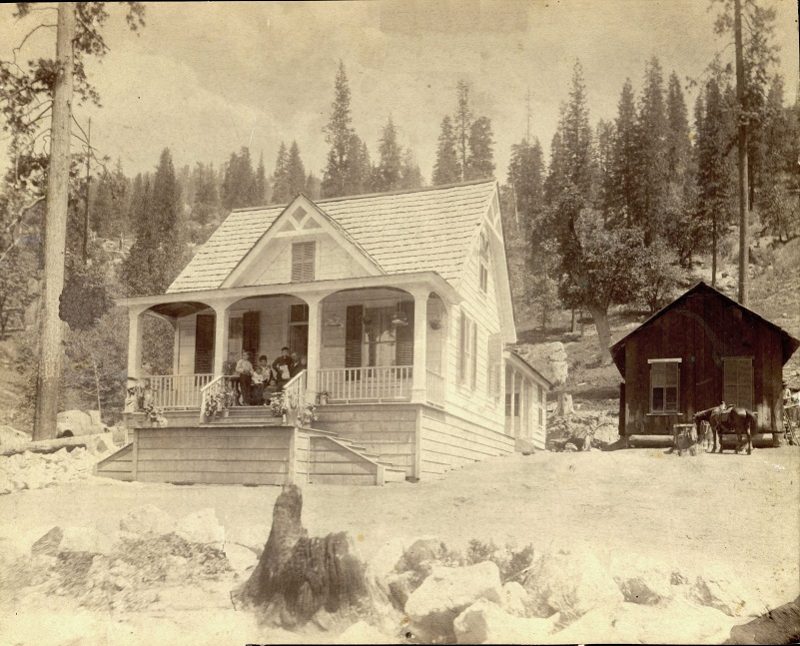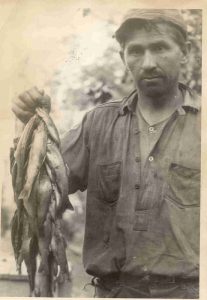 OAKHURST — Fresno Flats Historic Park invites the community to attend the June edition of their First Friday Lecture Series. On Friday, June 1, historian Tom Phillips presents a film about his great-uncle Jay C. Bruce who was, for three decades in the early 20th century, the appointed California state mountain lion hunter.
OAKHURST — Fresno Flats Historic Park invites the community to attend the June edition of their First Friday Lecture Series. On Friday, June 1, historian Tom Phillips presents a film about his great-uncle Jay C. Bruce who was, for three decades in the early 20th century, the appointed California state mountain lion hunter.
Phillips is the co-author of Yosemite’s Forgotten Pioneers: The Bruces of Wawona, written with Annie Reynolds, and he will present a short rare, historical film as the main part of his talk at Fresno Flats. The 42-minute movie about Jay C. Bruce and his early exploits was made in 1924 as a silent film. In 1953, Bruce recorded the audio that narrates the film today.
Phillips, who is on the board of the Mariposa Museum and History Center, has generational roots in this area. Jay C. Bruce is Phillips’ maternal uncle, and his family holds a collection of letters that date back to 1808. Originally from Scotland, the family came to America through New York, staying two years before the west beckoned and two of Jay’s uncles moved to California for the gold rush. Eventually the rest of the family followed. Jay was born in Hornitos in 1881, and grew up at the hotel complex in Wawona, where his family eventually had a homestead.
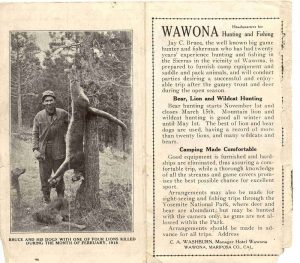 Mountain man Jay Bruce was a mandolin-playing, hunting and fishing phenomenon who once caught 32,000 trout in a two year period and even turned down a potential full ride to West Point or Annapolis in order to remain in the mountains he loved.
Mountain man Jay Bruce was a mandolin-playing, hunting and fishing phenomenon who once caught 32,000 trout in a two year period and even turned down a potential full ride to West Point or Annapolis in order to remain in the mountains he loved.
In his mid-thirties, according to Phillips, his great-uncle Jay was appointed to the position of Official Cougar Hunter for the State of California. It was a time when the term “wildlife management” usually meant protecting citizens and their livestock from wild predators, say experts now. Jay continued hunting lions for the state until he retired after 30 years of service with the Fish and Game Commission. In his time, he killed 669 mountain lions, 40 bears and hundreds of rattlesnakes, as well as snagging a few outlaws.
“Jay Bruce was thought of as a hero in the community because of his hunting abilities,” says Tom Phillips. “Many of the old families tell stories proudly of how their father or grandfather went hunting with Jay. At the time this all took place, mountain lions were the top predator. Many ranchers, farmers and families would lose their livestock to the lions. This was at a time when people’s lives and livelihoods were dependent on their livestock.”
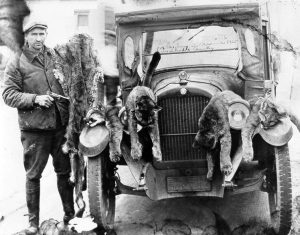 In 1923, Jay partnered with adventuring filmmakers, Henry Snow and his son, Sidney, who had just returned from a three-year African safari. The result of their expedition is the film, Jay Bruce Lion Hunter, that will be shown at Fresno Flats on Friday night.
In 1923, Jay partnered with adventuring filmmakers, Henry Snow and his son, Sidney, who had just returned from a three-year African safari. The result of their expedition is the film, Jay Bruce Lion Hunter, that will be shown at Fresno Flats on Friday night.
The film presents actual footage of Jay Bruce’s hunting trips when he worked for the Department of Fish and Game.
“There are some scenes, that in today’s environment may be considered gruesome, but when viewed from the historical point of view of the people who lived in that time, it was a natural part of life. My mother, Roberta Phillips, was Jay’s niece. When she was in grade school in San Francisco, Jay was invited to her school to present the film. Today, I would venture to say, that showing a film of this fashion would cause a riot to those not educated in the history of their forefathers.”
Jay’s natural education in the ways of wildlife was in contrast to those who were book-educated, Phillips points out, saying his great uncle’s observation of wildlife in the Sierra Nevada helped to educate people in the study of the environment.
“Jay was at the forefront of providing information on mountain lions. He was asked by many colleges to bring samples back for the research departments. Many famous California zoos asked Jay to bring them live lions for public education, display and research.”
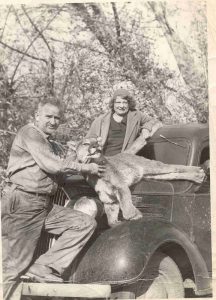 In retirement, Jay C. Bruce went on to write the book that Phillips says had been on his mind for years. Cougar Killer, published in 1953, became a best-seller.
In retirement, Jay C. Bruce went on to write the book that Phillips says had been on his mind for years. Cougar Killer, published in 1953, became a best-seller.
“Written with insight and descriptive power, the book brought him a nomination to honorary membership in the Mark Twain International Society,” explains the historian, adding that this was a prestigious honor, with luminaries present including Dwight Eisenhower, Winston Churchill and Ernest Hemingway.
Now, about hundred years after he was appointed to his position with the state, some of the behavior Jay observed in mountain lions has changed, Phillips notes.
“The range of the mountain lions is no longer just in the high Sierra — they are now found throughout the state, even in residential communities. Domestic animals are now falling victim to the mountain lion. More frequently the news tells stories of hikers, bicyclists, or joggers being attacked by mountain lions in the west.”
Want to learn more? Come to Fresno Flats on Friday night.
All photos courtesy of The Bruce Family
For the First Friday Lecture at Fresno Flats, doors open to the Cunningham Schoolhouse at 6 p.m. and the presentation begins at 6:30 p.m. Seating is limited, so organizers ask that you arrive early if you don’t want to stand in the back. While the event is free, donations are gladly accepted to support Fresno Flats and its historical research.
Fresno Flats Historical Park and Museum is located at 49777 School Road, Oakhurst, CA 93644
Jay Cook Bruce was born on September 20, 1881, at the Washington Mine near the town of Hornitos. When the Washington Mine was sold the family moved back to Wawona. Jay and his family lived at the Hotel complex where his parents were employed. In April of 1884, the Family homesteaded a piece of property across the Merced River from the Hotel Complex. Jay and his brother began a friendship with the Indian youth named, Joe. Joe taught the young Bruce boys how to use bow and arrows and how to track small game as well as many of the dangers of the wilderness.
Jay enjoyed hunting and found that the pelts of the small animals had a value at Thomas Hill’s Museum. Mr. Hill would purchase the pelts and sell them to the Hotel tourist. But fishing was where Jay would excel, In two seasons, he caught 32,000 trout for the Hotel.
In 1910, Jay married to Katherine Fournier. With the responsibility of a wife and family, Jay decided it was necessary to find a stable income. Jay opened a sawmill with a partner. By 1915, Jay lost both the sawmill and his house.
By 1918, when his mother passed away, having little option and a needed for cash, Jay sold his rights to the Homestead property in a bitter battle with his sibling.
To support his family, Jay returned to what he knew best, hunting. Jay hunted and conducted hunting parties in the High Sierras. He also worked as a guide in the Mariposa Grove, lecturing tourists about nature and wildlife. On January 1st 1919, he was offered the position of Official Cougar Hunter for the State of California. Jay continued hunting Lions for the state until he retired. Jay wrote and published a book and many articles. He made movies and lectured through out the country. Jay died in 1963 and is buried in Hollister California. — Bruce Family Archives, courtesy of Tom Phillips.
